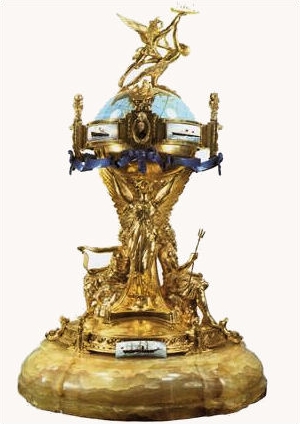By Robert Versteeg, associate of Silvin Books
After Richard René Silvin’s 2015 heavily attended presentation about the SS Normandie, the 1930s flagship of the French Line, he will once again return to LLS Jupiter on February 9, 2017 at 11:15 a.m. This time, he will take the audience on a journey through time, elaborating on the rise and decline of transatlantic ocean liner travel.
One of the featured stories is, of course, that of the Titanic, which almost everyone is familiar with. One of the reasons the Titanic hit the iceberg was because Captain Smith refused to reduce speed. The little understood reason, not covered in James Cameron’s 1997 film, was the White Star Line’s obsession to “capture” the coveted “Blue Riband.” But why did Captain Edward Smith endanger so many souls and what is the Blue Riband?
Transatlantic ocean crossings started to be competitive as early as the 1830s with the advent of “steam-assisted sailing ships.” Although the term Blue Riband had not yet been established, ships began to compete to cross the Atlantic Ocean the fastest. The Blue Riband was awarded to the ship, in regular service, which crossed the Atlantic at the fastest average speed. The term “record breaker” is awarded to a ship which breaks the speed record in both eastbound and westbound crossings.
The first ship to win the title of Blue Riband was the 175-foot, wooden, steam-assisted ship, Sirius. In 1838, she carried up to 40 passengers from England to New York in 18 days, 14 hours, and 22 minutes. Conditions aboard a tiny ship without heat, refrigeration or running water were horrific.Over the ensuing decades, several West European countries competed to improve these statistics, and, by 1909, Cunard Line’s steel hull, twin propeller driven, luxurious Mauretania “crossed” in 4 days, 10 hours, and 51 minutes.
By the beginning of the twentieth century, Cunard’s competitor, the White Star Line, was obsessed with capturing the Blue Riband title with their new flagship, the Titanic. This did not end well for the supposedly unsinkable ship and 1,514 of the 2,224 souls aboard. Consequently, the Mauretania held the title until 1929.
In 1936, British Parliamentarian Sir Harold K. Hales created a trophy to formalize the title and it was kept by the company which owned the fastest ship. The beautiful gold, silver and onyx trophy is 4 feet tall.
The last Atlantic liner to hold the Blue Riband is the American ship SS United States. She won the title and the trophy in 1952 by crossing in 3 days, 10 hours and 40 minutes. The Hales trophy still belongs to the now-mothballed ship and is on display at the American Merchant Marine Museum at King’s Point, New York. The advent of jet airliner travel has negated the need to operate high-speed ships.
Please join René as he takes you back through time, focusing on luxurious and glamorous ships. He will bring you through suspenseful moments, describing horrific ship accidents like the Lusitania and the Andrea Doria, as well as reveal many amusing anecdotal stories which took place aboard the Normandie, Queen Mary, Ile de France and the United States.










The Coast Guard Academy is not in King’s Point. It’s the Merchant Marine Academy.
Corrected now. Thank you.